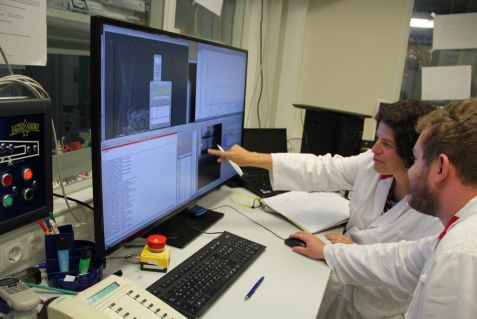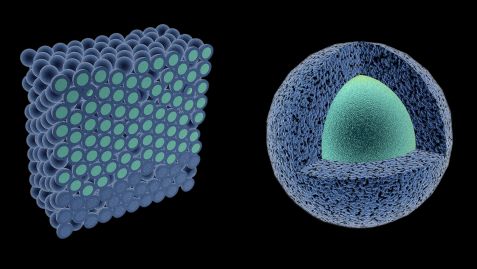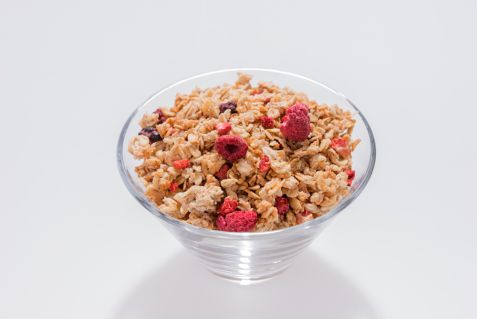MLZ is a cooperation between:
 > Technische Universität München
> Technische Universität München > Helmholtz-Zentrum Hereon
> Helmholtz-Zentrum Hereon
 > Forschungszentrum Jülich
> Forschungszentrum Jülich
MLZ is a member of:
 > LENS
> LENS > ERF-AISBL
> ERF-AISBL
MLZ on social media:

MLZ (eng)
Lichtenbergstr.1
85748 Garching
27.02.2020
Preserved and fresh
Neutrons show the details of the drying process during freeze drying
Freeze drying has provided us with tasty dried fruits in muesli, long-life yoghurt cultures and many other important products. For the first time, using neutron beams from the Heinz-Maier-Leibnitz (FRM II) research neutron source, a team of scientists has now been able to show us the drying process in detail. The process engineering has thus gained a method of testing theoretical models in practice.
Who doesn’t know the story: time in the morning is short, we have to get through breakfast quickly. The fruit muesli is poured into the bowl, a few spoonfuls of yogurt on top, finished. Here, many people have perhaps started to speculate, how exactly do the raspberries look so fresh and tasty.
The technology which makes this possible is freeze drying. Scientists at the Technical University of Munich (TUM) and the Otto von Guericke University Magdeburg have now been able to examine this process more closely with the help of neutrons. For the first time, they succeeded in observing the direct transition from ice to water vapor during the freeze drying of particles in an experiment.
Why do raspberries in muesli always look so fresh and tasty?

First author Sebastian Gruber and Prof. Dr. Petra Foerst evaluating the data of the freeze drying experiments. © Michael Schulz / TUM
“Freeze drying is a process which is mainly used in the pharmaceutical and food industries,” explains Sebastian Gruber, lead author of the study and doctoral candidate in food technology at the TUM.
When freeze drying, the objects containing water are frozen and placed in a vacuum chamber. Under low pressure, heat is added which sublimates the frozen water, i.e., it transitions directly from its solid state to its gaseous state. The dehydrated, unchanged structure of the material remains.
This is why freeze-dried raspberries look as though they have been freshly picked. But it isn’t just about the looks: Foods retain their taste and medicines are preserved without losing their efficacy.
In the literature, there are theoretical models about the freeze-drying process. “So far, however, no one has experimentally investigated the pattern according to which the ice in particles actually sublimes,” emphasizes Sebastian Gruber. It is precisely this sublimation front, meaning the area in which the ice vaporizes, which the researchers are interested in.
Neutrons make ice visible

Freeze drying of maltodextrin particles (dark blue = sugar matrix; turquoise = ice): The radial drying front in the particles runs from the outside to the inside. The planar drying front runs from bottom to top. © W. Schürmann / TUM
The neutron radiography instrument ANTARES at the Garching research neutron source provides the ideal prerequisites for the experiment. Because neutrons make water visible. “ANTARES is also particularly well suited to investigate samples under low pressure and low temperatures,” explains instrument scientist Dr. Michael Schulz from the TUM.
Using neutron radiography and tomography and the resulting 2D and 3D images, the scientists show that the ice sublimates from the particles of their sugar sample in a radial manner, and in a planar from the ground towards the center of the bed.
The findings will help to save time and costs
“Our aim is to further advance the research on the freeze-drying process in order to create better process conditions in the future,” Sebastian Gruber explains the motivation behind the research. “Because if the particle size, pressure or temperature cannot be coordinated in an ideal manner during sublimation, this can lead to a structural collapse and thus a loss in quality or efficacy.”
The industry is currently trying to counteract these undesired phenomena with longer drying processes. The behavior of the sublimations front, which has been experimentally confirmed for now, could contribute to minimizing the time taken and thus save energy and costs.
Original publication:
Estimation of the local sublimation front velocities from neutron radiography and tomography of particulate matter. S. Gruber, N. Vorhauer, M. Schulz, M. Hilmer, J. Peters, E. Tsotsas, P. Foerst. Chemical Engineering Science, 211, 16. Januar 2020, 115268. DOI: 10.1016/j.ces.2019.115268
Contact:
Prof. Dr.-Ing. Petra Först
Lehrstuhl für Systemverfahrenstechnik
Technische Universität München
Gregor-Mendel-Straße 4, 85354 Freising, Germany
Phone: +49 8161 71 3289
E-Mail: petra.foerst@tum.de
Sebastian Gruber, M.Sc.
Tel.: +49 8161 71 4187
E-Mail: sebi.gruber@tum.de
More information:
Press release of the Technical University of Munich
MLZ is a cooperation between:
 > Technische Universität München
> Technische Universität München > Helmholtz-Zentrum Hereon
> Helmholtz-Zentrum Hereon
 > Forschungszentrum Jülich
> Forschungszentrum Jülich
MLZ is a member of:
 > LENS
> LENS > ERF-AISBL
> ERF-AISBL
MLZ on social media:



